As the 1940s continued, Walt Disney did not—could not—dare to hope too much. His recent animated films had all ranged from complete box office failures to at best modest successes. The modest successes had nearly all included live action footage, suggesting that viewers might be more interested in Disney’s live action films than in Disney’s continued experiments with animation. Still, the studio was surviving—if barely—financially. Perhaps—just perhaps—the studio could start working on another full length animated film again. Nothing as elaborate as the pre-war films, of course, but something that would let the studio tell a full story again and possibly show off the character animation the studio had still been developing. Maybe something about princesses. With cute mice.
In the meantime, however, Walt Disney still needed to keep the studio’s doors open and give RKO Films a full length film. Still lacking the money—and the artists—for a full length film, he ordered the animators to produce yet another series of cartoon shorts. This particular collection would, like Fantasia, focus on combining animation with music—in this case, mostly cheerful songs. It would also, Walt Disney decided, showcase a couple of American folk heroes, to celebrate—and take advantage of—the postwar surge in American patriotism. And just to ensure that film audiences would flock to what would be a comparatively thin and short selection of cartoons, Melody Time would also feature a cameo from popular cowboy star Roy Rogers and his arguably even more popular horse, Trigger. Roy Rogers’ band, the Sons of the Pioneers, would sing.
The end result was, to put it kindly, a mixed bag of very unrelated cartoon shorts, from the sappy quasi romance of Once Upon a Wintertime, the surreal moments of Bumble Boogie and the Donald Duck cartoon short, Blame It on the Samba, the unexpected religious bent of The Legend of Johnny Appleseed, the almost cloying cuteness of Little Toot, and whatever is going on in Trees and Pecos Bill. The cartoons were loosely—very loosely—connected through narration and a motif of an animated brush painting an animated stage, but the varied feel of the cartoons can give more than a bit of a whiplash effect, especially since all but two of them are very short indeed.
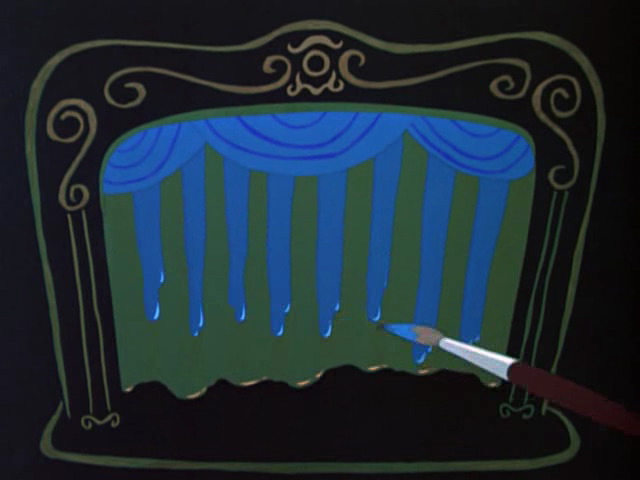
That tonal dissonance may also explain why, outside of the Bumble Boogie and Pecos Bill shorts, which Disney has frequently repackaged into other formats, Melody Time is one of the least known and least regarded of the anthology films—despite having, smack dab in the middle, groundbreaking special effects better than anything Disney had created in years, something they would not match until at least Mary Poppins and, arguably, until Who Framed Roger Rabbit and Honey I Shrunk the Kids.
This special effects breakthrough appears during the Donald Duck cartoon, Blame It on the Samba, a cartoon that’s pretty much a replay of the major weirdness of The Three Caballeros, and not just because it features the same characters. Donald Duck and José Carioca are all sad, presumably because instead of being in, well, the actual Brazil, they are trapped in some sort of flat, fake Brazil, and also because of the low box office takes for Saludos Amigos and The Three Caballeros—ok, maybe I’m reaching. Anyway, they are sad, so they get thrown into a giant cocktail glass by the Aracuan Bird.
This is not the weird part. The weird part is that the cocktail is then shaken and stirred to reveal a live action organ player, Ethel Smith, who plays on merrily as the now much happier ducks start dancing on the piano and as animated bubbles start rising up from the live action keyboard playing, and before we can start asking serious questions like WHY IS A KEYBOARD PLAYER LIVING AT THE BOTTOM OF A COCKTAIL GLASS the Bird is all like, hey, time for an amazing special effects sequence and blows up the organ, as, I guess, Aracuan Birds do, and the organist keeps playing as, I guess, organists trapped at the bottom of a cocktail glass forced to entertain depressed ducks do, and in the cool special effects bit—by 1940s standards—shots of her live action performance on now animated keyboard fragments continue even as the bits of the keyboard fly round and round. Then the bird folds up the samba menu apparently abandoning everyone else, leaving them forever trapped in a cocktail glass as they try to recover from a traumatizing experience with an exploding organ.
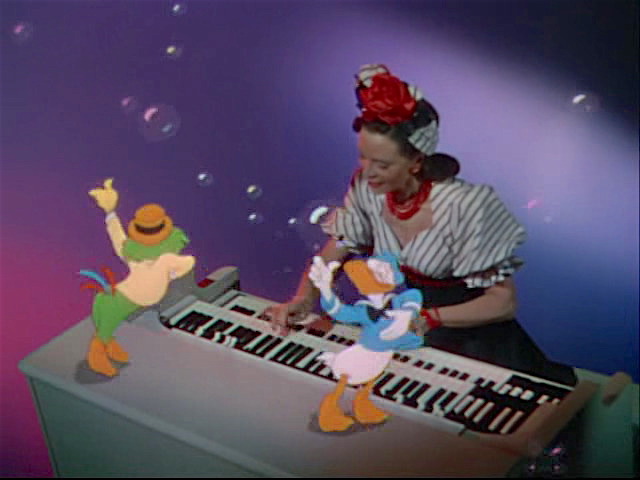
Whether or not any of this should indeed be blamed on a samba, or what exactly is going on here, are excellent questions, but the important thing is that the combined animation and live performance, however much it may lead to the question of “Huh?” and “Why,” represented a significant step up for Disney, far more technically difficult than the combined live action/animation sequences in The Three Caballeros. It did not, however, lead to a decision to continue in that direction. As it turned out, Disney’s very next film—So Dear to My Heart—would convince the studio that going forward, it was better off creating two lines of films: the cheaper live action films and the animated features, a decision the studio stayed with for years, until Mary Poppins. It’s a pity: this sequence suggests that Disney could have done amazing things with this combination.
The other innovative piece, on an animation level, was the Bumble Boogie segment. Originally planned as a possible segment for either the original Fantasia or an updated Fantasia, this is the most “Fantasia” like piece of the problem: free of narration and words, it follows a bumblebee on a surreal journey that matches the weirdest parts of the pink elephant sequence from Dumbo, with animators more or less saying, yeah, that sounds odd, go for it. Possibly the most memorable image is of the bee frantically trying to escape a moving keyboard: if the keyboard in Blame It on the Samba was under attack, the keyboard here is very much on the attack. It could, I think, be read as a metaphor for frazzled Disney artists feeling under attack by their very own art—or Walt Disney himself—but whatever the metaphor, this is probably Melody Time’s standout cartoon, a dazzling sequence of color and imagination.
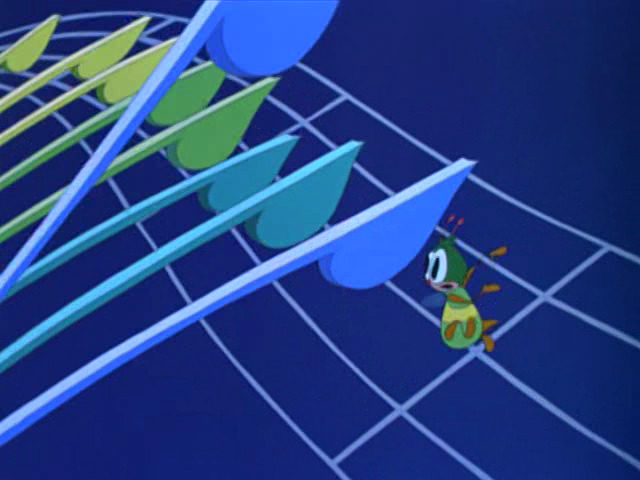
It stands out also because—unlike most of the other cartoons collected here—it doesn’t really tell a story, unless “Bumblebee gets chased by flowers cosplaying as trombones” counts as one. The only other cartoon of this type is Trees, basically a moving illustration of Alfred Joyce Kilmer’s “Trees,” chosen partly because of the poem’s popularity, and partly as another attempt to honor U.S. military forces: Kilmer died in combat in World War I. Your tolerance for this short will depend entirely on your tolerance for the poem, and more specifically, your tolerance for people singing this poem. It’s quite lovely with the sound off.
The rest of the cartoon shorts tell actual stories, with varying levels of success. Unfortunately enough, the hands down low point is the first cartoon, Once Upon a Wintertime—a low enough point that I almost gave up on the rest of the film. Here’s how it goes:
As syrupy music plays, a boy asks girl to go ice skating, taking her to the lake on a sled, and inspiring two bunnies to hop along, and it’s all nice and sappy until the boy showers the girl with snow, auugh, and the boy bunny pays more attention to the human girl than the bunny girl, auugh, and a skirt gets lifted. The annoyed girl and the annoyed bunny trot off, chins high up in the air, ignoring the boy bunny who is desperately waving a DANGER THIN ICE SIGN. Annoyed, the boy bunny PUSHES THE SIGN RIGHT INTO THE THIN ICE, CRACKING IT AND THEN RUNS AROUND CRACKING UP EVEN MORE OF THE ICE like THANKS BUNNY and you know what bunnies who do this sort of thing might just DESERVE to drown. Thanks to his bunny antics, the girl and the girl bunny find themselves trapped on a small piece of ice, about to fall off a waterfall TO THEIR DEATHS until they are saved by, I kid you not, squirrels, with the help of a couple of blue jays and some horses. And then the girls warm up the cold boys by kissing them on the cheek and FORGET TO THANK THE SQUIRRELS I hate this cartoon.
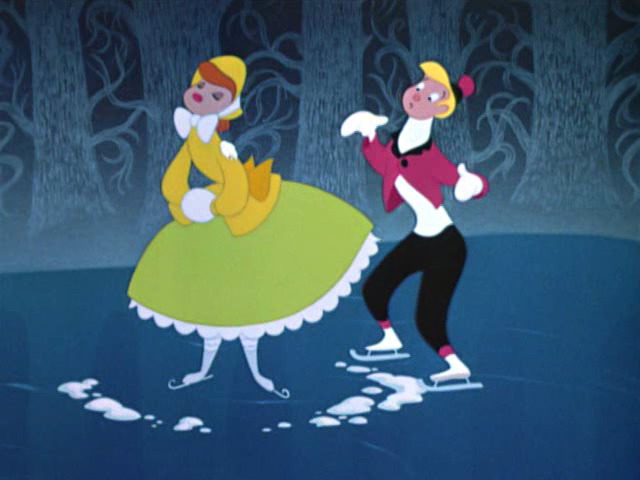
Apart from my many issues with the basic concept here—don’t get TOO offended by boyish tricks, girls, or you could fall off a waterfall unless helpful squirrels are around—and the lack of any likable characters other than the squirrels and the blue jays, who are barely in it, and the syrupy music—I find myself kind of startled by the sheer lack of heroism shown by everyone here but the squirrels. It was not the first or last time that Disney would give the heroic role to a non-protagonist, but it’s still a bit odd for Disney to feature characters who nearly get themselves killed and need to be rescued by bystanders. A hope, perhaps, that helpful squirrels will always be around—even for people too caught up in in their justified annoyance to notice the ground cracking beneath them.
Another short, Little Toot, is more successful. Featuring a small mischievous towboat called, you guessed it, Little Toot, this is a compact story of shifting from community troublemaker, to exile, to hero. Little Toot doesn’t start out as particularly sympathetic, thanks to his habit of blowing smoke into ocean liners and other tricks, even when he attempts to make up for this by trying to “help” his father—said help ending up sending a liner flying straight into a city. The resulting death and destruction are somewhat glossed over, but it’s not entirely surprising to see Little Toot dragged off to be tied up far away from shipping lanes.
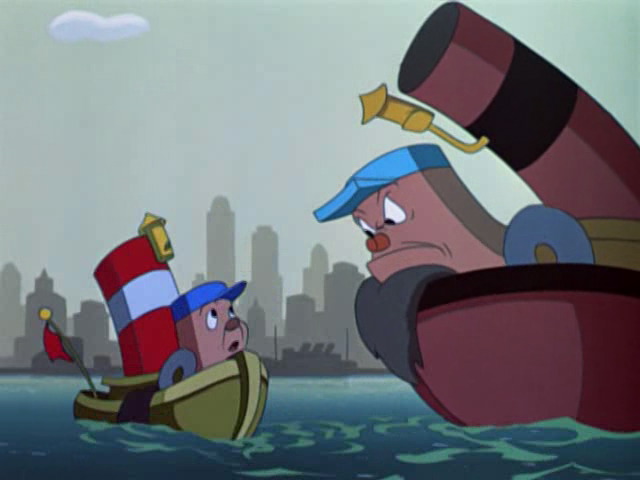
I’m not overly fond of the music that accompanies this cartoon either, and the animation is hardly among Disney’s greatest, but I do like the lesson here, that sometimes it’s not always easy to atone for your mistakes, and sometimes, trying to do so on your own—without asking the offended parties—can make things worse. It’s also one of Disney’s better examples of compact storytelling.
The third story cartoon, The Legend of Johnny Appleseed is one of Disney’s most overtly Christian works. Disney had, of course, used Christian imagery and theology before this. A short section of The Three Caballeros is dedicated to depicting a Christmas ritual, for instance, and Fantasia ends on the overtly religious note of Ave Maria. But this short goes a step further, featuring a protagonist, Johnny Appleseed, who merrily sings “The Lord is Good to Me,” and who is saved by a not exactly angelic looking guardian angel, who explains that there’s no better book than the Bible and recommends that Johnny take up a life of trees and missionary work. The decision to follow the angel’s call leads to Johnny Appleseed’s success and happiness.
This matches the biography of the real life Johnny Appleseed, John Chapman, a preacher, missionary and apple tree sower, who, legend claims, did sing this particular song as he worked with trees during his missionary trips. But the overtly, almost preachy nature of the short is a seemingly odd choice for a secular company known more for singing dwarfs, flying elephants and musical fantasies, and an odd choice to insert in a film that is otherwise firmly secular.
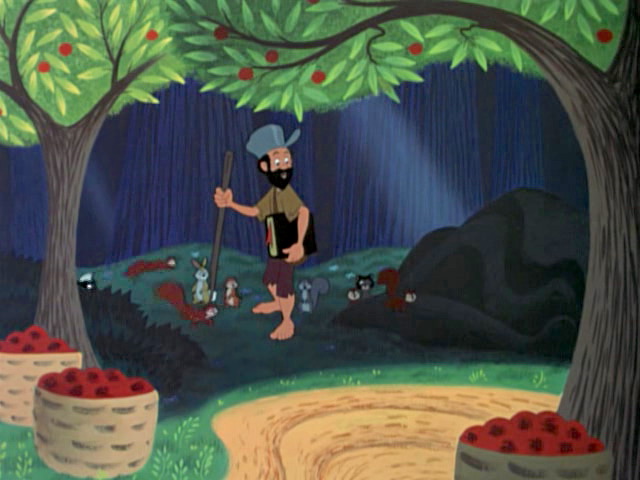
And yet, when placed in the context of the rest of the film, perhaps not that odd. The Legend of Johnny Appleseed, like many of the other shorts here, is a celebration of U.S. culture—a nostalgic celebration, looking back at what Walt Disney perceived as an older, simpler, better time. Thus the Once Upon a Wintertime, with its Currier and Ives look; the Trees cartoon, retelling a popular American poem; The Legend of Johnny Appleseed, presenting the pioneer period as an idyllic time in U.S. history, a moment when even a person seemingly lacking the strength, skills and funds to go out west could still bring apples to pioneers.
And, well, the last cartoon, Pecos Bill.
Pecos Bill is a retelling of the tall tales about, you guessed it, Pecos Bill, a character passed off as a bit of Texas oral folklore who turned out to be a completely made up bit of Texas oral folklore. However faked, the early insistence on those folklore origins, however, meant that Disney didn’t have to pay for the rights to Pecos Bill. Instead, they just had to write a nice little rhyming song about him and animate it. To that, they added a rather lovely animated sequence of the Wild West and desert plants, and a considerably less lovely (and terribly fake looking) live action bit featuring the popular Roy Rogers and Trigger the horse, before jumping into the many tales of how Pecos Bill shaped the Rio Grande river and his romance with Slue Foot Sue. Sue insists on wearing a tight bouncy bustle to be in her best looks at her wedding, and on riding Bill’s horse, Widowmaker. The affronted horse tosses Sue off; she lands on her bustle, and starts bouncing, going higher and higher until she lands on the moon—thanks, the short implies none too subtly, to her vanity. Pecos Bill ends up back with the coyotes.

In recent times—Amazon.com reviewer times—this segment has come under considerable criticism and controversy, not because of what it contains, but because of what it doesn’t contain—that is, the original cartoon. As part of Disney’s otherwise admirable anti-smoking campaign, the studio edited out an entire scene showing Pecos Bill smoking. And unlike some of the other edits designed to cover up some of Disney’s less acceptable moments, this one is visible—there’s a jump in the frame and in the soundtrack.
Removing the smoking I can understand. What is considerably harder to understand is why, after removing the brief smoking shot, Disney then left in an entire sequence with these lyrics, quoted word for word:
While a tribe of painted Indians did a war dance
Pecos started shooting up their little game
He gave them redskins such a shake up
That they jumped out of their makeup
That’s the way the Painted Desert got its name
So, smoking, bad, but exiling a woman to the moon because of vanity, fine, and playing that for laughs, also fine, shooting and terrorizing “redskins” and also playing that for laughs, fine. Great to know your priorities here, Disney.
I will just add that the Blame It on the Samba section still contains, after the latest edits, a frame showing a character smoking.
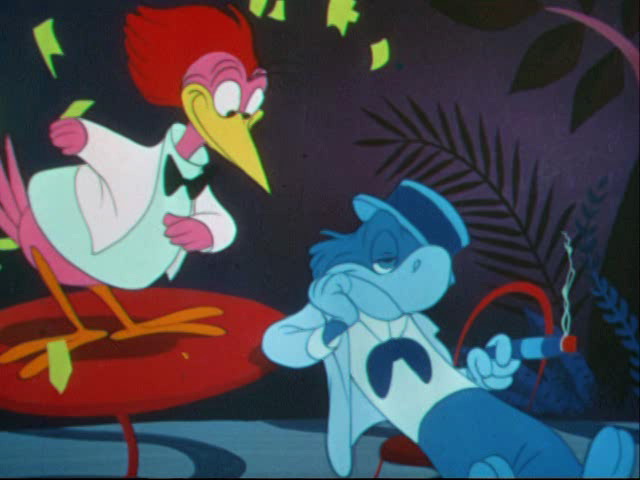
On the other hand, the Pecos Bill short does give us a relaxed if brief look at Roy Rogers, his horse Trigger (who does some horse tricks), and his band. So there’s that, I suppose.
What strikes me now is how much of this film is an echo—consciously or not—of earlier Disney films: the Bumble Boogie segment easily could have slid into Fantasia as a short—or as a replacement for the bit about the soundtrack; Blame It on the Samba is essentially a continuation of Saludos Amigos and The Three Caballeros; Little Toot is mostly an updated version of Pedro from Saludos Amigos; and both the Johnny Appleseed and Pecos Bill shorts are logical follow-ups to both The Martins and the Coys and Casey at the Bat from Make Mine Music: shorts that look back to an imaginary, more hopeful, prewar past.
And this perhaps explains the problem with Melody Time: some of the individual shorts here are fine, as far as they go, particularly Bumble Boogie, but the whole feels as if it is caught in the past, instead of leaping forward, caught in nostalgia, instead of bending reality, as its animators had done before. Nostalgia can be artistic, certainly, and parts of Melody Time are, but on the whole, this is a restrained, conservative film, an uneasy collection of parts that never quite form a whole.
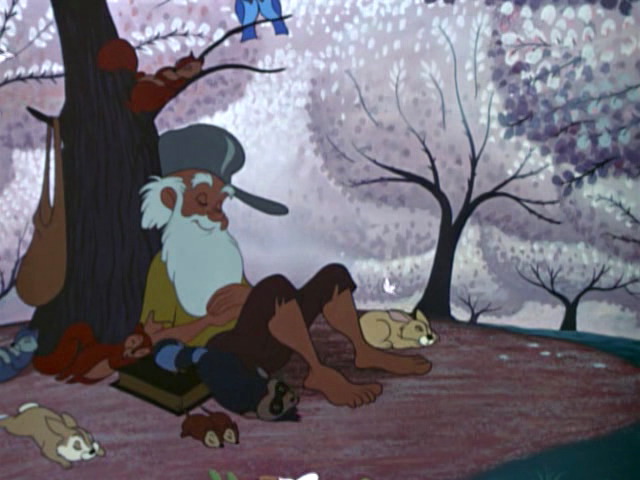
Initially, Melody Time’s main impact on the Disney studio was to inject just enough cash into the company coffers to let Walt Disney proceed with Cinderella. The film was later cannibalized into individual shorts, with Bumble Boogie and Little Toot finding far more success as individual cartoon shorts than as uneasy parts of this package film. Pecos Bill more or less inspired one of the Magic Kingdom restaurants, The Pecos Bill Tall Tale Inn and Café, which now focuses on Mexican food, and images of him and Slue Foot Sue can be glimpsed at most of the Frontierland sections in the various Disney parks. Some of the Melody Time characters made brief appearances on Disney Trading Pins, and the Hollywood Studios park previously displayed some of the original animation cels from the film. That area is now a Star Wars exhibit, but cast members are hopeful that the animation cels will be on display again once the park’s current expansion is complete.
For the most part, however, Melody Time became one of Disney’s most forgotten films, as Disney gave up on the package films, instead focusing on shorts and full length features. Including one of their most memorable features, Lady and the Tramp, really and truly this time coming up next. I mean it. Really.
Mari Ness lives in central Florida.










